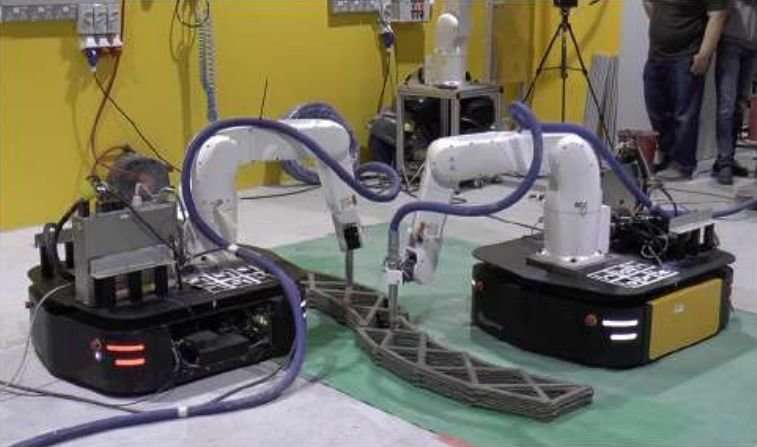August 30, 2018 weblog
Future construction team: As robots move, they work on single-piece structure

The construction industry of the future will increasingly turn to 3D printing, as researchers go from strength to strength in devising printing systems suited for building structures. The latest buzz looks at what a Singapore team has accomplished, in showing moving robots at work.
Nanyang Technological University and colleagues have shown that two machines can operate on a single project working in tandem.
The mobile robots are shown in a video performing 3D printing a large structure and they are doing it fairly quickly. Evan Ackerman in IEEE Spectrum said, "Roboticists at Nanyang Technological University in Singapore have, for the first time (as far as they know), performed 'the actual printing of a single-piece concrete structure by two mobile robots operating concurrently.'"
In their paper, "Large-scale 3D Printing by a Team of Mobile Robots," the team said they used the Ubuntu operating system for system integration, ROS for device control among other things, and OpenRAVE for planning and collision-checking.
You can see two robots in the video concurrently put their "noses" down to the ground to get busy on concurrent printing. Worth noting is the robots' mobility. In the building and construction industry, a 3D printing solution often means printing smaller pieces, to be assembled on-site. What may result are process complexities and potential weaknesses at the assembly interfaces.
So, is it the way it has to be—one must print in pieces and assemble later? To tackle size restrictions of printers on site, this team of researchers from the Nanyang Technological University in Singapore removed the size restrictions of a printer altogether by using robotic arms on mobile platforms.
Their workaround: multiple mobile robots concurrently printing a large, single-piece, structure. 3DPrinting.com, describing the system's features, wrote, "The system holds a robotic arm atop moving robotic cars with mini motion tyres."
The construct would offer projects deploying the robots some flexibility and freedom—the machines, even if put to work in building projects that vary in area, need not undergo system changes.
"They are freer in their operation parameters," said Rawal Ahmed on Tuesday. The robots define their own build volume in moving around.
What's next? Ackerman and other writers reporting on the mobile robots for construction said the team now looks forward to hashing out further improvements, as this is only proof of concept.
An article in 3ders.org wrote about one of the improvements they are considering.
"While the height of the printed objects is still limited by the reach of the robotic arms, they still have way more flexibility than other systems when it comes to length and width. However, this also could be overcome with bots of an industrial scale, and in fact, the team is already thinking about extending the reach of the robots arms by putting them on scissor lifts."
Ackerman raised the issue of construction print speed and the potential of their research, if you can "throw a bunch of robots at a big project, with each one tackling a different piece at the same time."
IEEE Spectrum said that "Large-scale 3D Printing by a Team of Mobile Robots," by Xu Zhang, Mingyang Li, Jian Hui Lim, Yiwei Weng, Yi Wei Daniel Tay, Hung Pham, and Quang-Cuong Pham from Nanyang Technological University in Singapore, appears in the journal Automation in Construction.
More information: Xu Zhang et al. Large-scale 3D printing by a team of mobile robots, Automation in Construction (2018). DOI: 10.1016/j.autcon.2018.08.004
Abstract
Scalability is a problem common to most existing 3D printing processes, where the size of the design is strictly constrained by the chamber volume of the 3D printer. This issue is more pronounced in the building and construction industry, where it is impractical to have printers that are larger than actual buildings. One workaround consists in printing smaller pieces, which can then be assembled on-site. This workaround generates however additional design and process complexities, as well as creates potential weaknesses at the assembly interfaces. In this paper, we propose a 3D printing system that employs multiple mobile robots printing concurrently a large, single-piece, structure. We present our system in detail, and report simulation and experimental results. To our knowledge, this is the first physical demonstration of large-scale, concurrent, 3D printing of a concrete structure by multiple mobile robots.
© 2018 Tech Xplore



















